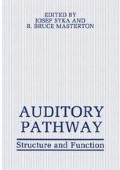Abstract
Humans perceive the pitch of a harmonic complex tone without its fundamental as identical with that of the fundamental presented alone (the phenomenon of the missing fundamental) (cf. de Boer, 1976). In psychophysical experiments, rhesus monkeys were able to match harmonic complex tones with fundamentals to the same without fundamentals (Tomlinson and Schwarz, 1987). It was concluded that rhesus monkeys could perceive the pitch of the missing fundamental. This percept is generally thought to arise within the central nervous system (Houtsma and Goldstein, 1973; Terhardt, 1972). We studied the auditory cortex of alert monkeys to determine how stimulus features relevant to pitch perception might be encoded. Single neurons in auditory cortex of unanesthetized monkeys were isolated, the units’ sensitivity to pure tones and noise stimuli were determined, and sideband inhibition was assessed, typically with two tones. We then applied various complex tones and compared the responses to those obtained using the previous simpler stimuli.
Access this chapter
Tax calculation will be finalised at checkout
Purchases are for personal use only
Preview
Unable to display preview. Download preview PDF.
References
de Boer, E., 1976, On the residue and auditory pitch perception, in: “Handbook of Sensory Physiology”, Vol. V/3, 479–583.
Goldstein, J. L., 1973, An optimum processor theory for the central formation of the pitch of complex tones, J. Acoust. Soc. Am., 54: 1496–1516.
Houtsma, A. J. M. and Goldstein, J. L., 1972, The central origin of the pitch of complex tones: Evidence from musical interval recognition, J. Acoust. Soc. Am., 51:520–528.
Pick, G. F., 1977, Comment on paper by Scharf and Meiselman, in: “Psychophysics and Physiology of Hearing”, P. Wilson and E. F. Evans, eds., Academic Press, London, 233–234.
Plomp, R., 1964, The ear as a frequency analyser, J. Acoust. Soc. Am., 36:1628–1636.
Scharf, B. and Meiselman, C. H., 1977, Critical bandwidth at high intensities, in: “Psychophysics and Physiology of Hearing”, P. Wilson and E. F. Evans, eds., Academic Press, London, 221–232.
Terhardt, E., 1972, Zur Tonhoehenwahrnehmung von Klangen, Acustica 26: 173–199.
Author information
Authors and Affiliations
Editor information
Editors and Affiliations
Rights and permissions
Copyright information
© 1988 Plenum Press, New York
About this chapter
Cite this chapter
Tomlinson, R.W.W., Schwarz, D.W.F. (1988). Resolution of Components of Harmonic Complex Tones by Single Neurons in the Alert Auditory Cortex. In: Syka, J., Masterton, R.B. (eds) Auditory Pathway. Springer, Boston, MA. https://doi.org/10.1007/978-1-4684-1300-7_37
Download citation
DOI: https://doi.org/10.1007/978-1-4684-1300-7_37
Publisher Name: Springer, Boston, MA
Print ISBN: 978-1-4684-1302-1
Online ISBN: 978-1-4684-1300-7
eBook Packages: Springer Book Archive

